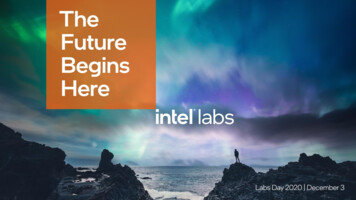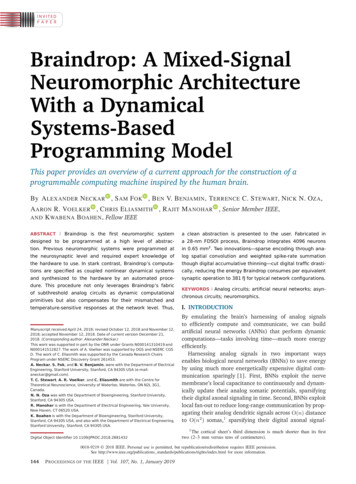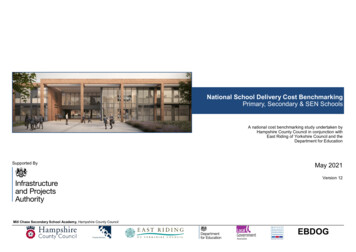
Transcription
Early Benchmarking Resultsfor Neuromorphic ComputingMike DaviesSenior Principal Engineer and Director,Neuromorphic Computing LabLabs Day 2020
Rethinking Computing Bottom-UpLoihi CharacteristicsCompute and Memory Integratedto spatially embody programmed networksTemporal Neuron Models (LIF)to exploit temporal correlationSpike-Based Communicationto exploit temporal sparsitySparse Connectivityfor efficient dataflow and scalingThe Brain1,400,000 mm380B neuronsLoihi60 mm3128K neuronsOn-Chip Learningwithout weight movement or data storageDigital Asynchronous Implementationfor power efficiency, scalability, and fastprototypingNo floating-point numbers,No multiply-accumulatorsNo batching, No off-chip DRAMlabs
Nature Machine Intelligence Reference:Benchmarks for Progress in Neuromorphic ComputingNature Machine Intelligence, Vol 1, Sept 2019.labs
Seeking Order of Magnitude Gains In energy efficiency In speed of processing data – especiallysignals arriving in real time In the data efficiency of learning andadaptation With programmability to span a widerange of workloads and scales With long-term plans to reduce costwith process technology innovationslabs
The Challenge: SNN Algorithm Discovery“Deep Learning” /Artificial Neural NetworksMACHINE LEARNINGNEUROSCIENCE132COMPETITIVE COMPUTER ARCHITECTURES“Neuromorphic Networks”(Spiking, Event-Based)labs
The Challenge: Algorithm DiscoveryDeep Learning Derived ApproachesMACHINE LEARNINGNEUROSCIENCE ANN conversion to rate-coded deep SNNsSNN backpropagationOnline SNN approximate backpropMathematically Formalized1133 Neural Engineering Framework (NEF)Locally Competitive Algorithm for LASSOStochastic SNNs for solving CSPsSimilarity and graph search with temporal spike codesHyperdimensional computingPhasor associative memoriesDynamic neural fields and continuous attractor networks2New Ideas Guided by Neuroscience2COMPETITIVE COMPUTER ARCHITECTURES Olfaction-inspired rapid learning“RatSLAM” for mapping and navigationCortical microcircuit modelsEvolutionary optimization of SNNslabs
Deep Network Conversion for Keyword SpottingLoihi providesextremely goodscaling vsconventionalarchitectures asnetwork size growsby 50x(Lower is better)Loihi is the most energy-efficient architecturefor real-time inference (batchsize 1 case)8(Higher is better)(Lower is better)Loihi consumes 5-10x lower energy than closest conventional DNN architectureFor workloads, configurations, and results, see Blouw et al, “Benchmarking Keyword Spotting Efficiency on Neuromorphic Hardware.” arXiv:1812.01739. Results May Vary.labs
Directly Trained SNNsfor Event-based Vision Tactile SensingObject ClassificationLoihi outperforms on all metrics vs GPU1: 20% faster 45x lower powerFor workloads, configurations, and results, see Event-Driven Visual-Tactile Sensing and Learning for Robots Tasbolat Taunyazov, Weicong Sng, Hian Hian See, Brian Lim, Jethro Kuan,Abdul Fatir Ansari, Benjamin Tee, and Harold Soh Robotics: Science and Systems Conference (RSS), 2020. Results may vary.1labs
Adaptive Control of a Robot Arm Using Loihi SNN adaptive dynamic controllerimplemented on Loihi allows a robot armto adjust in real time to nonlinear,unpredictable changes in systemmechanics1, 2 Loihi outperforms with 40x lower power,2x faster control rate compared to aGPU31DeWolf, T., Stewart, T. C., Slotine, J. J., & Eliasmith, C. (2016, November). A spiking neural model of adaptive arm control. InProc. R. Soc. B (Vol. 283, No. 1843, p. 20162134). The Royal Society.2Eliasmith, “Building applications with next generation neuromorphic hardware." NICE Workshop 2018DeWolf, T., Jaworski, P., Eliasmith, C. (2020). Nengo and Low-Power AI Hardware for Robust, Embedded Neurorobotics.Frontiers in Neurorobotics. Results may vary.3labs
An Example 3000x More Data Efficient than DLBio-inspired odor learning and recognitionLoihi’s bio-inspired algorithmOlfactoryBulbOlfactoryCortexDAELimbic SystemEntorhinal CortexLoihi reaches 92%accuracy with onesampleSingle-shot learning performanceDeep Learning solution (deepautoencoder)Nabil Imam and Thomas Cleland, Nature Machine Intelligence, March 2020labs
Optimization, Planning, Constraint SatisfactionProblems solved by Loihi to date: LASSO regression Graph search (Dijkstra) Constraint Satisfaction (CSP) Boolean satisfiability (SAT)Benefits: Over 105 times lower energy-delay-productfor solving constraint satisfaction problemsvs CPU1 Up to 100x faster graph search2 Even greater gains for LASSOLoihi: Nahuku 32-chip system with NxSDK 0.98CPU: Core i7-9700K w/ 32GB RAM running 1 [Task 13] Coin-or branch and cut (https://github.com/coin-or/Cbc) or 2 [Task 12] NetworkX (for graph search)See backup for additional test configuration details. Performance results are based on testing as of July 2020 and may not reflect all publicly available security updates. Results may vary.labs
Latin Squares Solver: Quantitative ResultsOver 40x fasterOver 2,500x lower energy(Lower is better)(Lower is better)[Task 13]CBC/CPU: Core i7-9700K w/ 32 GB RAM running Coin-or branch and cut (https://github.com/coin-or/Cbc)Loihi: Nahuku 32-chip system with NxSDK 0.98See backup for additional test configuration details. Performance results are based on testing as of July 2020 and may not reflect all publicly available security updates. Results may vary.labs
SLAM (Simultaneous Localization and Mapping)Fundamental task for any device (robot, AR glasses)that needs to autonomously acquire spatial awarenessNeuromorphic components: 1D attractor ring(s) for pose estimation 2D position network (“place cells”) Map learning Loop closureDemonstrated on Loihi to date: Basic proof-of-concept functionality 100x lower dynamic power vs GMapping library on CPU11 [Task10] For workloads, configurations, and results, see Tang, G., Shah, A., & Michmizos, K. P. (2020). Spiking Neural Network on Neuromorphic Hardwarefor Energy-Efficient Unidimensional SLAM. 4176–4181. https://doi.org/10.1109/iros40897.2019.8967864. Results may vary.labs
Nearest Neighbor Search on Pohoiki SpringsInput image:k-NN on Loihi: Novel use of fine-grain parallelism andsparse temporal matching and searching 1 million pattern datasets Up to 1k search key dimensionalityOutput(s):Benefits:12 Up to 4x faster latency or 80-300xfaster index generation than state-ofthe-art CPU implementations3 Supports adding new patterns online inmilliseconds4Lesser matches indicated by later spikes 650x better energy-delay-productcompared to CPU implementation[Task 11] For workloads, configurations, and results, see EP Frady et al, “Neuromorphic Nearest-Neighbor Search Using Intel's Pohoiki Springs.” arXiv:2004.12691. Results may vary.labs
For the Right Workloads, Loihi Provides Orders ofMagnitude Gains in Latency and EnergyCPU (Intel Core/Xeon)GPU (Nvidia)Movidius (NCS)TrueNorthNovel(Better on Loihi)Directly trainedConverted with rate codingReferencearchitecture(Worse on Loihi)See backup for references and configuration details. Results may vary.labs
Standard feed-forward deep neural networks give theleast compelling gains (if gains at all)CPU (Intel Core/Xeon)GPU (Nvidia)Movidius (NCS)TrueNorthNovel(Better on Loihi)Directly trainedConverted with rate codingReferencearchitecture(Worse on Loihi)See backup for references and configuration details. Results may vary.labs
Recurrent networks with novel bio-inspired propertiesgive the best gainsCPU (Intel Core/Xeon)GPU (Nvidia)Movidius (NCS)TrueNorthNovel(Better on Loihi)Directly trainedConverted with rate codingReferencearchitecture(Worse on Loihi)See backup for references and configuration details. Results may vary.labs
Compelling scaling trends:Larger networks give greater gainsCPU (Intel Core/Xeon)GPU (Nvidia)Movidius (NCS)TrueNorthNovel(Better on Loihi)Directly trainedConverted with rate codingReferencearchitecture(Worse on Loihi)See backup for references and configuration details. Results may vary.labs
What this Implies for the Technology OutlookScaled up systems Solve hard problems quicklyReal-time pattern matchingRecommendation systemsGraph analyticsScientific computing, HPCEdge tureEvent-Based Sensing Enables novel AI algorithms Online adaptation learning Real-time temporal dataprocessing Low power low latencyOrders of magnitude lower latency and powerRe-thinking visual sensing – electronic retinaTactile sensing – electronic skinActive sensingCalls for sensor-level integration with neuromorphicprocessinglabs
Legal InformationPerformance varies by use, configuration and other factors. Learn more at www.Intel.com/PerformanceIndex .Performance results are based on testing as of dates shown in configurations and may not reflect all publicly available updates. See backup forconfiguration details. No product or component can be absolutely secure.Your costs and results may vary.Results have been estimated or simulated.Intel technologies may require enabled hardware, software or service activation.Intel does not control or audit third-party data. You should consult other sources to evaluate accuracy.Intel disclaims all express and implied warranties, including without limitation, the implied warranties of merchantability, fitness for a particularpurpose, and non-infringement, as well as any warranty arising from course of performance, course of dealing, or usage in trade. Intel Corporation. Intel, the Intel logo, and other Intel marks are trademarks of Intel Corporation or its subsidiaries. Other names and brands maybe claimed as the property of others. labs
References and System Test Configuration Details[Task 1] P Blouw et al, 2018. arXiv:1812.01739[Task 8] T. DeWolf et al, “Nengo and Low-Power AI Hardware for Robust,Embedded Neurorobotics,” Front. in Neurorobotics, 2020.[Task 2] TY Liu et al, 2020, arXiv:2008.01380[Task 3] KP Patel et al, “A spiking neural network for image segmentation,”submitted, in review, Aug 2020.[Task 4] Loihi: Nahuku system running NxSDK 0.95. CIFAR-10 imagerecognition network trained using the SNN-Toolbox (code available athttps://snntoolbox.readthedocs.io/en/latest). CPU: Core i7-9700K with 32GBRAM, GPU: Nvidia RTX 2070 with 8GB RAM. OS: Ubuntu 16.04.6 LTS, Python:3.5.5, TensorFlow: 1.13.1. Performance results are based on testing as of July2020 and may not reflect all publicly available security updates.[Task 9] Loihi Lasso solver based on PTP Tang et al, “Sparse coding by spikingneural networks: convergence theory and computational results,”arXiv:1705.05475, 2017. Loihi: Wolf Mountain system running NxSDK 0.75.CPU: Intel Core i7-4790 3.6GHz w/ 32GB RAM running Ubuntu 16.04 withHyperThreading disabled, SPAMS solver for FISTA, http://spamsdevel.gforge.inria.fr/.[Task 10] G Tang et al, 2019. arXiv:1903.02504[Task 11] EP Frady et al, 2020. arXiv:2004.12691[Task 5] Loihi: Nahuku system running NxSDK 0.95. Gesture recognitionnetwork trained using the SLAYER tool (code available athttps://github.com/bamsumit/slayerPytorch). Performance results are basedon testing as of July 2020 and may not reflect all publicly available securityupdates. TrueNorth: Results and DVS Gesture dataset from A. Amir et al, “Alow power, fully event-based gesture recognition system,” in IEEE Conf.Comput. Vis. Pattern Recog. (CVPR), 2017.[Task 12] Loihi graph search algorithm based on Ponulak F., Hopfield J.J. Rapid,parallel path planning by propagating wavefronts of spiking neural activity.Front. Comput. Neurosci. 2013. Loihi: Nahuku and Pohoiki Springs systemsrunning NxSDK 0.97. CPU: Intel Xeon Gold with 384GB RAM, runningSLES11, evaluated with Python 3.6.3, NetworkX library augmented with anoptimized graph search implementation based on Dial’s algorithm. Seealso http://rpg.ifi.uzh.ch/docs/CVPR19workshop/CVPRW19 Mike Davies.pdf[Task 6] T. Taunyazov et al, 2020. RSS 2020[Task 13] Loihi: constraint solver algorithm based on G.A. Fonseca Guerra andS.B. Furber, Using Stochastic Spiking Neural Networks on SpiNNaker to SolveConstraint Satisfaction Problems. Front. Neurosci. 2017. Tested on theNahuku 32-chip system running NxSDK 0.98. CPU: Core i7-9700K with 32GBRAM running Coin-or Branch and Cut (https://github.com/coin-or/Cbc).Performance results are based on testing as of July 2020 and may not reflectall publicly available security updates.[Task 7] Bellec et al, 2018. arXiv:1803.09574. Loihi: Loihi: Wolf Mountainsystem running NxSDK 0.85. CPU: Intel Core i5-7440HQ, with 16GB runningWindows 10 (build 18362), Python: 3.6.7, TensorFlow: 1.14.1. GPU: NvidiaTelsa P100 with 16GB RAM. Performance results are based on testing as ofDecember 2018 and may not reflect all publicly available security updates.Results may vary.labs
without weight movement or data storage Digital Asynchronous Implementation for power efficiency, scalability, and fast . Rethinking Computing Bottom-Up Loihi 60 mm3 128K neurons The Brain 1,400,000 mm 80B neurons. labs Nature Machine Intelligence Reference: Benchmarks for Progress in Neuromorphic Computing Nature Machine Intelligence, Vol 1 .










